Once-reviled scavenger bird now the pride of its Indian home
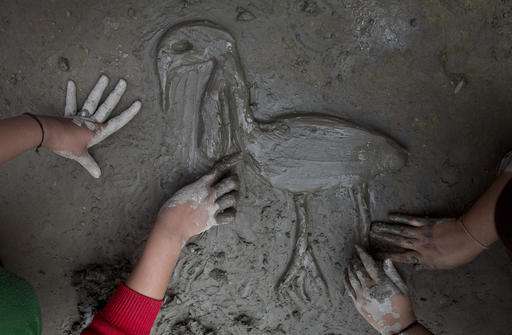
The greater adjutant stork used to be an object of revulsion in northeast India. It's not a pretty bird, with its large, dull-orange bill and gray, black and white plumage. A carnivore and scavenger, it left bits of dead animals in its nests. People thought it brought bad luck, so they destroyed nests and sometimes poisoned the birds.
The fortunes of the species may turn on local pride.
Local women took it upon themselves early last year to form a conservation movement for the bird in Assam state, one of only three homes the species has left. The women known as the hargila army, for the bird's name in the Assamese language, sing hymns and weave scarves and other items on handlooms with motifs of the bird to create awareness about the need to protect the species.
Only 1,200 of the large storks survive in the world, according to estimates from the International Union for Conservation of Nature and Natural Resources. Assam has about two-thirds of them, largely in three villages just northwest of state capital Gauhati.
The other 400 or so greater adjutant storks are found in the eastern Indian state of Bihar and in Cambodia.
The conservation movement wasn't easy to sell; wildlife biologist Purnima Devi Barman needed almost eight years to convince locals the bird was crucial to the ecosystem.
"It was seen as a bird with an evil omen that brings in carcass and other rotten stuff," said Barman, who works with a local conservation group called Aranyak.
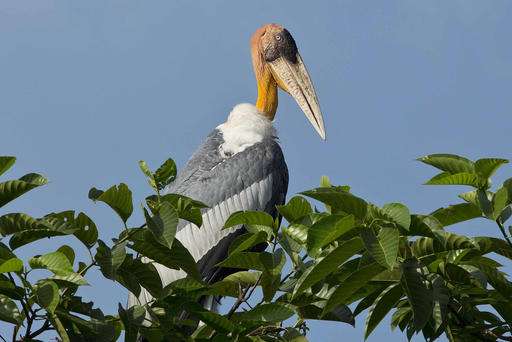
"We had to involve the locals because the bird nests on trees owned by individual households. The future of the greater adjutant stork depends on individual tree owners who used to fell trees earlier to get rid of the nests," Barman said.
The locals now call Barman "hargila baideo," or hargila sister, after she organized and named the movement, now involving nearly 150 women.
Once the women began to feel pride in ensuring the survival of the bird, they spread the message.
Hymns are sung in the local prayer hall for the stork's survival. At Sankardev Sishu Niketan, the school where most local children study, the teachers talk about protecting the bird.

"We have launched a pride campaign among the children and youth so they can proudly say their village is home to the hargilas," Barman said.
The movement also found support from local government authorities, who have provided nets to protect young storks falling out of the nest during storms or windy days. The critical period is the breeding season from August to April.
"We are providing looms for the weavers and educational grants to children of tree owners in the area as they are going all out in protecting the bird," said Vinod Sachan, the local district magistrate.
In January more than two dozen greater adjutant storks were found dead in a neighborhood near Gauhati. Forensic testing is being done to learn the cause.
"The news of so many hargilas dying has cast a pall of gloom amongst us. We need to do more to save this globally endangered bird," said Barman.
-

In this Jan. 24, 2017, photo, a Greater Adjutant Stork scavenges for food at a garbage dumping site on the outskirts of Gauhati, India. For decades the big and awkward looking carnivore and scavenging bird was the object of revulsion in its home in northeast India until a group of women took it upon themselves to save the endangered bird. They called themselves the hargila army, for the bird's name in the local Assamese language. In January more than two dozen Greater Adjutant Storks were found dead in this. (AP Photo/ Anupam Nath) -

In this Feb. 6, 2017, photo, children ride past a billboard displaying the Greater Adjutant Stork, an endangered bird with a total population of 1,200 in the world, at Dadara village, west of Gauhati, India. A group of women have taken it upon themselves to save the endangered bird and call themselves the hargila army, for the bird's name in the local Assamese language. With about 800 birds Assam has the largest number of the Greater Adjutant Stork, concentrated largely in three villages just northwest of state capital Gauhati. (AP Photo/Anupam Nath) -
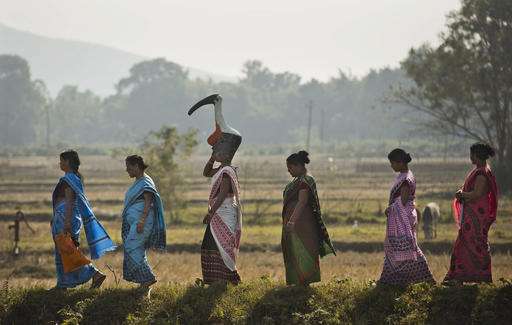
In this Feb. 4, 2017 photo, a group of women from the "hargila army" walk to attend an awareness meeting on protecting the Greater Adjutant Stork in Dadara village, west of Gauhati, India. For decades the big and awkward looking carnivore and scavenging bird was the object of revulsion in its home in northeast India until a group of women took it upon themselves to save the endangered bird. Women from the hargila army, for the bird's name in the local Assamese language, pray, sing hymns, weave scarves and other items on their handlooms with the motifs of the bird, to create awareness about the need to protect the species. (AP Photo/Anupam Nath) -

In this Feb. 4, 2017, photo, wildlife biologist Purnima Devi Barman, second left, who works with a local conservation group called Aranyak, shows photographs of storks to a group of women from the "hargila army," during an awareness meeting to save the bird, in Dadara village, west of Gauhati, India. For decades the big and awkward looking carnivore and scavenging bird was the object of revulsion in its home in northeast India until a group of women took it upon themselves to save the endangered bird. Women from the hargila army, for the bird's name in the local Assamese language, pray, sing hymns, weave scarves and other items on their handlooms with the motifs of the bird, to create awareness about the need to protect the species. (AP Photo/Anupam Nath) -
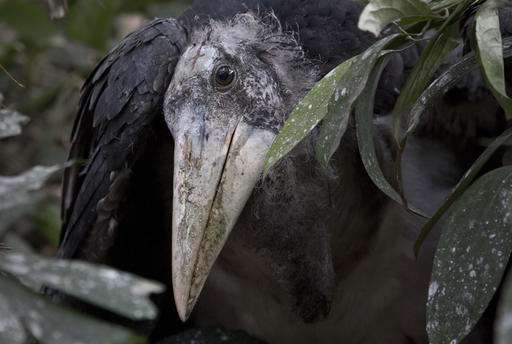
In this Feb. 4, 2017, photo, an injured baby Greater Adjutant Stork lies on the ground after falling from a nest in Dadara village, west of Gauhati, India. For decades the big and awkward looking carnivore and scavenging bird was the object of revulsion in its home in northeast India until a group of women took it upon themselves to save the endangered bird. Nearly 150 local women now pray, sing hymns, weave scarves and other items on their handlooms with the motifs of the bird, to create awareness about the need to protect the species. The movement also found support from local government authorities who have provided nets to be put below trees where the storks nest so that the young birds do not die or get injured during storms or windy days. The critical period is the breeding season which is August to April. (AP Photo/Anupam Nath) -
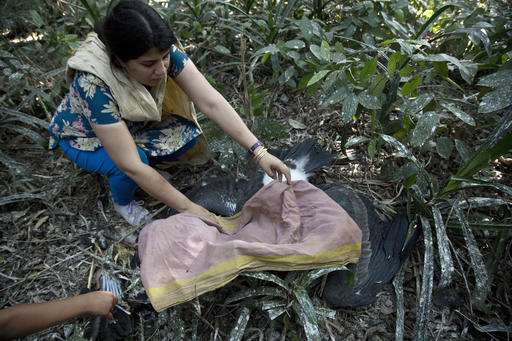
In this Feb. 4, 2017, photo, wildlife biologist Purnima Devi Barman, who works with a local conservation group called Aranyak, rescues a baby Greater Adjutant Stork that feel from its nest on a tree in Dadara village, west of Gauhati, India. As a result of a conservation movement spearheaded by Barman, local women in this region pray, sing hymns, weave scarves and other items on their hand looms with the motifs of the bird, to create awareness about the need to protect the species, only 1200 of which survive in the world, according to estimates from the International Union for Conservation of Nature and Natural Resources. With about 800 birds Assam has the largest number of the Greater Adjutant Stork, concentrated largely in three villages just northwest of state capital Gauhati. (AP Photo/Anupam Nath) -

In this Jan. 24, 2017, photo, Greater Adjutant Storks fly over a garbage dumping site on the outskirts of Gauhati, India. For decades the big and awkward looking carnivore and scavenging bird was the object of revulsion in its home in northeast India until a group of women took it upon themselves to save the endangered bird. They called themselves the hargila army, for the bird's name in the local Assamese language. In January more than two dozen Greater Adjutant Storks were found dead in this. (AP Photo/Anupam Nath) -

In this Jan. 24, 2017, photo, a forest official washes a carcass of a Greater Adjutant Stork, an endangered bird, near a garbage dumping site in the Deepor Beel wildlife sanctuary, on the outskirts of Gauhati, India. For decades the big and awkward looking carnivore and scavenging bird was the object of revulsion in its home in northeast India. "It was seen as a bird with an evil omen that brings in carcass and other rotten stuff," wildlife biologist Purnima Devi Barman, who works with a local conservation group called Aranyak, said. "We had to involve the locals because the bird nests on trees owned by individual households. The future of the Greater Adjutant Stork depends on individual tree owners who used to fell trees earlier to get rid of the nests," Barman said. (AP Photo/Anupam Nath) -

In this Feb. 4, 2017, photo, a member of "hargila army," the name of the endangered Greater Adjutant Stork in local Assamese language, displays a weave with motifs of the bird in Dadara village, west of Gauhati, India. For decades the big and awkward looking carnivore and scavenging bird was the object of revulsion in its home in northeast India until the hargila army took it upon themselves to save the endangered bird. With about 800 birds Assam has the largest number of the Greater Adjutant Stork in the world, concentrated largely in three villages just northwest of state capital Gauhati. (AP Photo/Anupam Nath) -
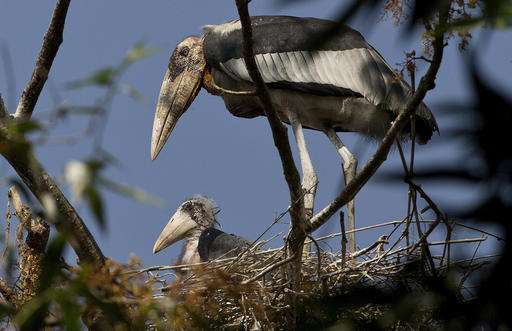
In this Feb. 4, 2017, photo, a Greater Adjutant Stork, an endangered bird, rests in a nest with a baby at Dadara village, west of Gauhati, India. For decades the big and awkward looking carnivore and scavenging bird was the object of revulsion in its home in northeast India until a group of women took it upon themselves to save the endangered bird. They called themselves the hargila army, for the bird's name in the local Assamese language. Nearly 150 local women now pray, sing hymns, weave scarves and other items on their handlooms with the motifs of the bird, to create awareness about the need to protect the species. (AP Photo/Anupam Nath) -
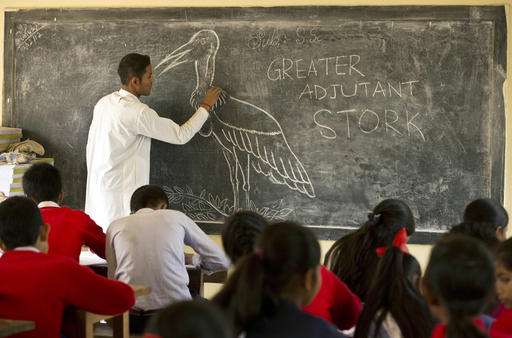
In this Feb. 6, 2017, photo, a teacher of Sankardev Sishu Niketan school draws a Greater Adjutant Stork, an endangered bird with a total population of 1,200 in the world, on a blackboard at Dadara village, west of Gauhati, India. With about 800 birds Assam has the largest number of the Greater Adjutant Stork, concentrated largely in three villages just northwest of state capital Gauhati. Conservationists say they have launched a pride campaign among the children and youth so they can proudly say their village is home to the hargilas, the name of the bird in local Assamese language. (AP Photo/Anupam Nath) -
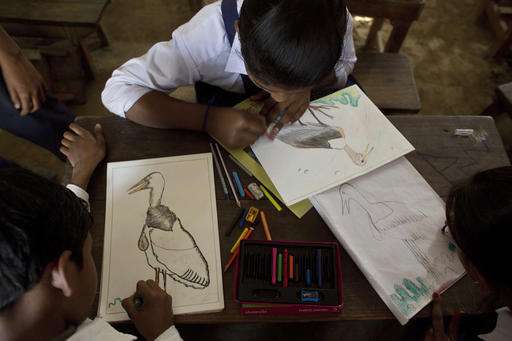
In this Feb. 6, 2017, photo, students of Sankardev Sishu Niketan school draw Greater Adjutant Storks, an endangered bird with a total population of 1,200 in the world, in their classroom at Dadara village, west of Gauhati, India. With about 800 birds Assam has the largest number of the Greater Adjutant Stork, concentrated largely in three villages just northwest of state capital Gauhati. Conservationists say they have launched a pride campaign among the children and youth so they can proudly say their village is home to the Hargilas, the name of the bird in local Assamese language. (AP Photo/Anupam Nath) -
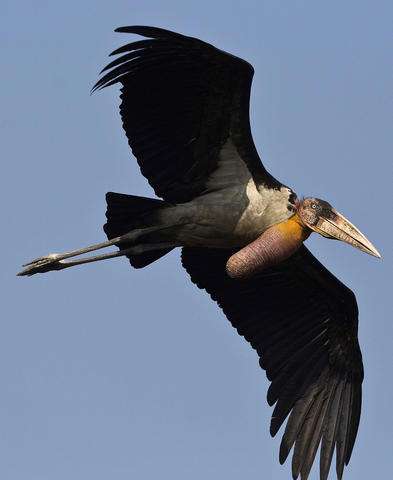
In this Feb. 4, 2017, photo, a Greater Adjutant Stork, an endangered bird with a total population of 1,200 in the world, flies at Dadara village, west of Gauhati, India. For decades the big and awkward looking carnivore and scavenging bird was the object of revulsion in its home in northeast India until a group of women took it upon themselves to save the endangered bird. They called themselves the hargila army, for the bird's name in the local Assamese language. Nearly 150 local women now pray, sing hymns, weave scarves and other items on their handlooms with the motifs of the bird, to create awareness about the need to protect the species. (AP Photo/Anupam Nath)
© 2017 The Associated Press. All rights reserved.


















